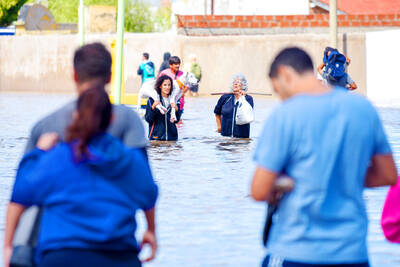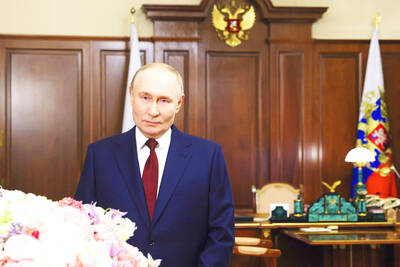With US President Barack Obama shifting his nuclear nonproliferation strategy to rogue states and terrorists, Chile has become an example of how small countries can play a big part in making the world safer.
Vast amounts of highly enriched uranium (HEU) are being stored in relatively insecure locations around the world. Just 25kg of it — the size of a grapefruit — could create a mushroom cloud of radioactivity and devastate an entire city if detonated.
At a nonproliferation summit on Monday in Washington, Obama will encourage leaders from 47 countries to work with the US to secure and remove HEU from reactors, as Chile finally did last month.
“We are happy to see it go,” Fernando Lopez of the Chilean Nuclear Energy Commission said after the secret transfer of the material from reactors near Santiago to the US.
“Countries normally don’t want to be loaded with waste from other countries,” Lopez acknowledged. “To put it in a safe place is valuable for everybody.”
The new US strategy considers a nuclear attack by terrorists or the spread of nuclear weapons technology to rogue nations to be greater threats than the Cold War fear of a communist enemy initiating a nuclear Armageddon.
Obama acknowledged the reduced threat from old enemies as he and Russian President Dmitry Medvedev prepared to sign a treaty yesterday to reduce the number of nuclear warheads their governments have ready to fire.
“For the first time, preventing nuclear proliferation and nuclear terrorism is now at the top of America’s nuclear agenda,” Obama said.
Even as aftershocks from last month’s magnitude 8.8 earthquake shook their equipment, US and Chilean engineers worked together to carefully extract Chile’s last HEU. It was no simple operation — the radioactive material was carefully loaded into specially designed casks and then lowered into two huge shipping containers for the ocean voyage. All told, 54.42 tonnes of metal were needed to keep just 18kg of HEU from leaking radioactivity.
After two-and-a-half weeks at sea, including passage through the Panama Canal, a specially outfitted double-hulled ship arrived under US Coast Guard escort at the Charleston Weapons Station in South Carolina last month.
Customs agents and nuclear inspectors made radiation checks as the containers were loaded onto flatbed trucks and then driven to the Savannah River Site in South Carolina and the Y-12 National Security Complex in Oak Ridge, Tennessee, where much of it will be converted to safer fuel and resold for nuclear power.
A year ago, Obama made a promise to lead a global effort to recover all of this material within four years — ambitious because it not only requires years of planning and diplomacy, but also highly specific technology and expertise.
No other country but the US has put all these elements together — even Russia depends on US help to safely dispose of uranium.
The US has already helped convert or verified the shutdown of 67 reactors in 32 countries from HEU to low-enriched uranium, which is much harder to weaponize. It also has secured HEU supplies in more than 750 vulnerable buildings and removed 2,691kg of weapons-grade nuclear material for safer storage.
To help keep his promise, Obama has proposed a 68 percent increase in the Global Threat Reduction Initiative’s budget to US$559 million for next year, not only to recover more HEU but also to prevent smuggling of nuclear material by strengthening export and border controls and port security.
Next year’s US$2.7 billion budget for nuclear nonproliferation work begins to do this for plutonium as well, committing US$300 million for a plant at Savannah River to convert 34,000kg of plutonium recovered from warheads to fuel for nuclear power.

ANGER: A video shared online showed residents in a neighborhood confronting the national security minister, attempting to drag her toward floodwaters Argentina’s port city of Bahia Blanca has been “destroyed” after being pummeled by a year’s worth of rain in a matter of hours, killing 13 and driving hundreds from their homes, authorities said on Saturday. Two young girls — reportedly aged four and one — were missing after possibly being swept away by floodwaters in the wake of Friday’s storm. The deluge left hospital rooms underwater, turned neighborhoods into islands and cut electricity to swaths of the city. Argentine Minister of National Security Patricia Bullrich said Bahia Blanca was “destroyed.” The death toll rose to 13 on Saturday, up from 10 on Friday, authorities

Two daughters of an Argentine mountaineer who died on an icy peak 40 years ago have retrieved his backpack from the spot — finding camera film inside that allowed them a glimpse of some of his final experiences. Guillermo Vieiro was 44 when he died in 1985 — as did his climbing partner — while descending Argentina’s Tupungato lava dome, one of the highest peaks in the Americas. Last year, his backpack was spotted on a slope by mountaineer Gabriela Cavallaro, who examined it and contacted Vieiro’s daughters Guadalupe, 40, and Azul, 44. Last month, the three set out with four other guides

Local officials from Russia’s ruling party have caused controversy by presenting mothers of soldiers killed in Ukraine with gifts of meat grinders, an appliance widely used to describe Russia’s brutal tactics on the front line. The United Russia party in the northern Murmansk region posted photographs on social media showing officials smiling as they visited bereaved mothers with gifts of flowers and boxed meat grinders for International Women’s Day on Saturday, which is widely celebrated in Russia. The post included a message thanking the “dear moms” for their “strength of spirit and the love you put into bringing up your sons.” It

‘LIMITING MYSELF’: New Zealand’s foreign minister said that the omments by Phil Goff were ‘disappointing’ and made the diplomat’s position in the UK ‘untenable’ New Zealand’s most senior envoy to the UK has lost his job over remarks he made about US President Donald Trump at an event in London this week, New Zealand Minister of Foreign Affairs Winston Peters said yesterday. Phil Goff, who is New Zealand’s High Commissioner to the UK, made the comments at an event held by international affairs think tank Chatham House in London on Tuesday. Goff asked a question from the audience of the guest speaker, Finnish Minister of Foreign Affairs Elina Valtonen, in which he said he had been re-reading a famous speech by former British prime minister Winston